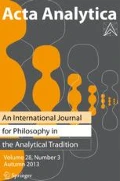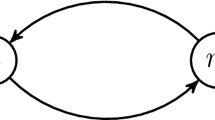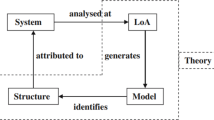Abstract
In this paper, I shall evaluate a strategy recently used to try to demonstrate the impossibility of behaviorally undetectable spectrum inversion. After showing that the impossibility proof proves too much, I shall identify where it goes wrong. In turn, I shall explain why someone attracted to functionalist and representationalist assumptions might rightly remain agnostic about the possibility of inversion.
Similar content being viewed by others
Notes
This assumption is not my assumption, but an assumption crucial to the argument against the possibility of inversion. If you think that it’s only possible for a subject to be linguistically competent in the use of our color language if the phenomenal character of this subject’s experience is indistinguishable from our own, you might reject this step in the argument. I shall grant it for the sake of discussion if only to show that we can grant this assumption and say that the inversion hypothesis remains a live possibility.
For discussion, see Thau (2002). While he’s right that you can square representationalism with the possibility of inversion by denying CR, I think we’re not forced to deny that our experiences represent colors.
This is important. Amy and Bianca will never face a situation in which they see something red. This means that while they will have different behavioral dispositions, they will not be disposed to respond differently to any situation they will ever encounter. If it is possible for such subjects to nevertheless both come to mean green by ‘green’, I can’t see that this difference in behavioral dispositions will matter. If you think it is impossible for such subjects to come to mean green by ‘green’, I suspect that you are working from some assumptions about language use and learning that should lead you to say that Ingrid and Norma cannot come to mean the same things in their uses of color terms. I’m fine with that, but then you think, as I think, that the argument for the incoherence of inversion in the previous section fails. You just think it fails at a much earlier step than I am arguing here.
I think that Gibbons and Sundstrom aren’t necessarily alone in moving too quickly from claims about what these subjects believe to what these subjects’ experiences must be like. In his discussion, Thau raises the rhetorical question, concerning pairs of subjects both of whom believe something they see is red, “if our respective visual experiences lead each of us to believe that it’s red, how could either of our visual experiences fail to represent it as red?” (2002, 13).
Thanks to Luke Robinson for the example.
References
Brewer, B. (1999). Perception and reason. New York: Oxford University Press.
Gibbons, J. (2005). Qualia: They’re not what they seem. Philosophical Studies, 126, 397–428.
Harman, G. (1990). The intrinsic quality of experience. Philosophical Perspectives, 4, 31–52.
Kripke, S. (1980). Naming and necessity. Cambridge, MA: Harvard University Press.
Millar, A. (2000). The scope of perceptual knowledge. Philosophy, 75, 73–88.
Shoemaker, S. (1982). The inverted spectrum. Journal of Philosophy, 79, 357–381.
Smith, D. (2002). The problem of perception. Cambridge, MA: Harvard University Press.
Sundstrom, P. (2002). An argument against spectrum inversion. In S. Lindström & P. Sundström (Eds.), Physicalism, consciousness and modality: essays in the philosophy of mind (pp. 65–94). Umeå: The Department of Philosophy and Linguistics.
Thau, M. (2002). Consciousness and cognition. New York: Oxford University Press.
Tye, M. (2000). Consciousness, Color, and Content. Cambridge, MA: MIT University Press.
Acknowledgments
I would like to thank Mark Decker, John Gibbons, Howard Hewitt, Leo Iacono, Pete Mandik, and Brad Thompson for incredibly helpful discussions of the issues discussed in this paper. I would also like to thank Robert Howell and Amy Kind for their written comments on earlier versions of this paper.
Author information
Authors and Affiliations
Corresponding author
Rights and permissions
About this article
Cite this article
Littlejohn, C. On the Coherence of Inversion. Acta Anal 24, 127–137 (2009). https://doi.org/10.1007/s12136-009-0048-2
Received:
Accepted:
Published:
Issue Date:
DOI: https://doi.org/10.1007/s12136-009-0048-2




